人教版高中英语必修二第三单元教学设计
- 格式:doc
- 大小:1.72 MB
- 文档页数:12
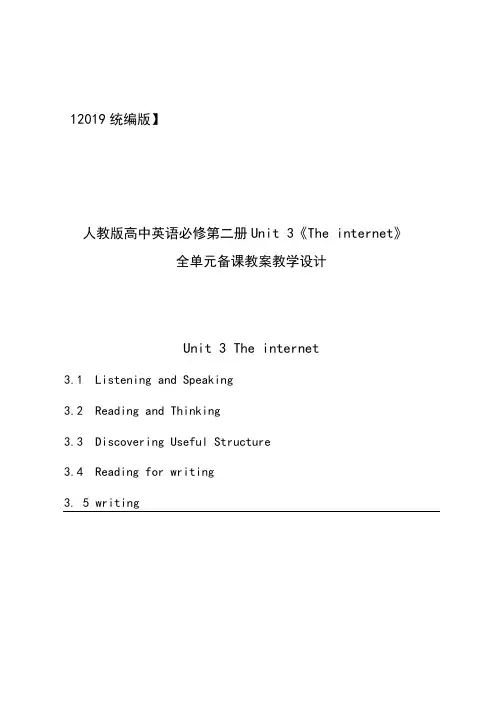
12019统编版】人教版高中英语必修第二册Unit 3《The internet》全单元备课教案教学设计Unit 3 The internet3.1Listening and Speaking3.2Reading and Thinking3.3Discovering Useful Structure3.4Reading for writing3. 5 writingUnit 3 The InternetListening and Speaking【教学目标】1.Guide students to understand the content of listening texts in terms of listening fbr definitions.2.Cultivate students' ability to define words and understand an investigation interview.3.Instinct students to use functional sentences of the dialogue such as “how much time do you spend online every day? What do you usually do online? and so on to maintain the convei’sation appropnately.4.Enable students to naturally use the fimctional and notional items of this unit to express their guess, expectation or belief.【教学重难点】1.Cultivate studentslistening strategies by learning ways to define new words.2.Enable students to naturally use the Rinctional and notional items of this unit to express their guess, expectation or belief.【教学过程】Part 1: Listening and SpeakingStep 1: Lead inTlie teacher is advised to talk with the meaning of the sentence in the opening page Boys and girls, before our listening, let's work in pail's and discuss:Tlie iiiteniet is becoming the town square fbr the global village of tomonow.How do you understand the sentence?Have the Ss discuss and share their vieM,.(It means the Internet has made the world closer together; we can interact on the Internet just like meeting at the square.)Step 2: Warming upAfter their small talk, the teacher can ask students to talk about their online habits:What do you usually do when you are online?• write a blog post• use a search engine• Chat online• W^tch Stream movies and musicStep 3: Sam is doing a survey on online habits. He is now talking to his schoolmates Aima Paul, and Joe. Listen to the conversation and complete the following tasks.Name Anna Paul JoeStep 4: Activity 3 & 41. Then, play the tape again. And after fiiiisliing listening, the students need to solve the following tasks.Fill in the blanks to complete the sentences.1) A blog an online diaiy where you write about something you're interested , I like basketball, so I write a lot on my blog about my favorite team.2) I stream videos and music, I watch videos and listen to music online.3) A search engine that helps you find what you'ie lookingfbr.Tlien check the answers with partners.2. Look at Activity 3 again. How are the words in italics defined? Write them in the coixect brackets. Pay attention the listening tips.A. Use simpler words.( ) B. Use an example.( ) C. Compare to sometliing.( )Step 5: Speaking ProjectWbik in pairs or groups and role play a conversation.Take turns to ask each other about your online habits.A: How much time do you spend online every day?B: Oh, it's hard to say. Sometimes I'm too busy to go online. Sometimes I spend more Time spentonline every day Online activities Reasons for using the Internetthan four hours online. How about you?A:It depends. I'd say from half an hour to three hours.B:What do you usually do online?A:I listen to music, stream videos, or look up infbnnation. And you?B:Lots of things. I especially like to chat with my friends and family. By the way, what's your favorite app?A:Well, English fun dubbing.B:Why do you like it?A:Tliere are lots of streams and I can dub interesting English movie clips so I can leam English in a Rui way.B:Sounds amazing. I certainly will tiy it.A:Ok, let me teach you how to download the app.B:Tliaiiks a lot.Part 2. Listening and TalkingStepl: Listen to the tape, and then ask the students to solve the following tasks.Choose the best app.Laura and Xiao Bo are talking about apps. Listen to their conversation and find out what apps they want.Xiao Bo is looking for a(n)app to help him get in shape.Laura would like an app for getting and another that will make her________________ better.Step2: Listen again. Are the sentences true T or false F?1.Both of Xiao Bo's apps keep track of the steps he takes.2.Xiao Bo's second app can help him make a fitness plan.ura needs an app that will help her get discounts.ura needs an app that will add money to her bank account.Step 3: Get the Ss to listen once more and tick the sentence they hear. Underline the words used to express predictions, guesses, and beliefs. Then check the answers.Predictions, Guesses, and BeliefsIt might help me walk more.My guess is that it wouldn't work.I imagine this app would help me get fit fasterI suppose that would be good.I guess you could save a little with tliis app.I suppose there would be some problems, too.I believe tliis app could help me get tliiimer.Step 4: Speaking ProjectLook at the description of some apps. Tlien role-play the conversation. Wliich app do you think would be more popular or usefill? Have the Ss discuss and share with the class.A:I imagine that TV Me would be more popular. Everyone watches TV and I think lots of people imagine themselves as actors in the TV shows, so putting the two together would be gieat. "What do you think?B:My guess would be Hear It First because it's both interesting and useful. You could find out more about the stones you like and make sure that you don't miss anything important.I believe both the young and old would like it.Unit 3 The InternetReading and Thinking【教学目标与核心素养】1.Instinct students to talk about how to use the hiteniet appropriately.2.Encourage students to combine their own life experience of using the Internet and link the text with thek real life.3.Stimulate students to enhance reading skills by using the mind map.4.Encourage students to contribute their own strength, help the people around to explore the virtual world online, and experience the magic of the Intemet.【教学重难点】1.Enable the Ss to talk about the related topic.2.Guide the Ss to summarize the main idea of each paragiaph as well as the main idea of the text.3.Help Ss leani some basic reading skills, such as prediction, sunimaiy and so on.【教学过程】Step 1: Wamiiiig up and predictionRead the title and tiy to guess what the text will be about?Some changes caused by the Iiiteniet.Learning tip:Step 2: Skimming for general ideas1.What's the main idea of the passage?A. Jan developed a serious illness.B. Jan decided to start an IT chib.C. Jan started a charity website.D. Jan's life has been changed by the Internet.2.Jan's attitude to the Internet is .A. negativeB. neutralC. gratefillD. not mentioned3.What's the purpose of the author by refeiTiiig to the 59-year-old man and the 61-year-old woman?A.To introduce two old people.B.To explain how to apply for jobs online.C.To piove they are successfill.D.To give two examples helped by Jan's club.Step 3: Scanning for detailsRead the passage quickly to solve the following questions.Read the text and answer the questions.1.Why did Jan quit her job?2.How did the people in the online community help her?3. Why did she start the IT club?4. What is the "digital divide”?5.What's Jan's next goal?6.What can we leani from her experiences?Step4: Carefxil reading for main ideas of each paiagraph.Read carefiilly and figure out the main idea of each paiagraph.Paragi-aph 1. People's lives have been changed by online conunuiiities and social networks.Paragi'aph 2. Jan developed a serious illness which made her stuck at home, but surfing the Internet can remove the distance between people.Paragi'aph 3. Jan decided to start an IT club to teach old people how to use computers and the Internet.Paragi'aph 4. Jan has started taking online classes to leani more about how to use the Internet to make society better.Paragi-aph 5. Jan's life has been greatly impioved by the Internet.Step 5: Speaking ProjectCritical thinking:(l)How do you anange your time spent on study and the Internet? Is itreasonable?(2)Wliat are your online activities? Are they safe?Have the Ss discuss and practice speaking then.Step 6 Homework:Review what we have learned and find out the key language points in the text.Unit 3 The Internet Discovering UsefulStructure 【教学目标】1. Guide students to review the basic usages of the Present Perfect Passive Vbice.2. Lead students to leam to use some special cases conceniiiig the Present Pei&ct Passive Voice flexibly.3. Enable students to use the basic phrases structures flexibly.4. Strengthen students' great interest in gi -ammar leaniiiig.【教学重难点】1. Help students to appreciate the fimction of the Present Perfect Passive Voice in a sentence.2. Instinct students to write essays using the proper the Present Peiiect Passive \bice.【教学过程】Step 1: Reviewing引导学生观察下列句子特点,总结共同点。
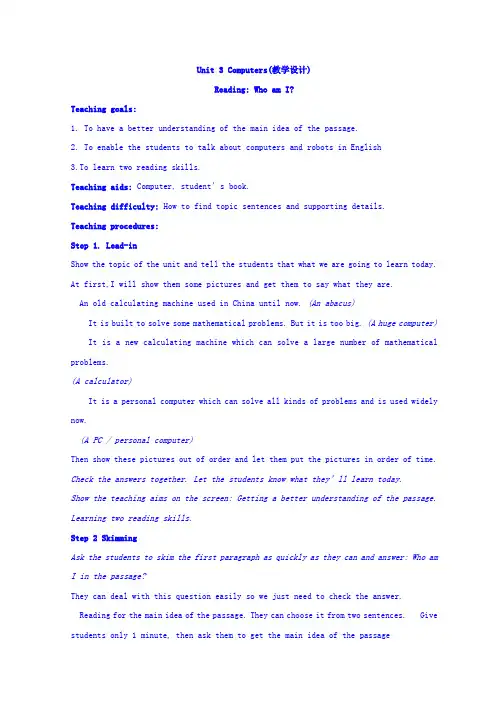
Unit 3 Computers(教学设计)Reading: Who am I?Teaching goals:1. To have a better understanding of the main idea of the passage.2. To enable the students to talk about computers and robots in English3.To learn two reading skills.Teaching aids: Computer, student’s book.Teaching difficulty: How to find topic sentences and supporting details.Teaching procedures:Step 1. Lead-inShow the topic of the unit and tell the students that what we are going to learn today. At first,I will show them some pictures and get them to say what they are.An old calculating machine used in China until now. (An abacus)It is built to solve some mathematical problems. But it is too big. (A huge computer) It is a new calculating machine which can solve a large number of mathematical problems.(A calculator)It is a personal computer which can solve all kinds of problems and is used widely now.(A PC / personal computer)Then show these pictures out of order and let them put the pictures in order of time. Check the answers together. Let the students know what they’ll learn today.Show the teaching aims on the screen: Getting a better understanding of the passage. Learning two reading skills.Step 2 SkimmingAsk the students to skim the first paragraph as quickly as they can and answer: Who am I in the passage?They can deal with this question easily so we just need to check the answer.Reading for the main idea of the passage. They can choose it from two sentences. Give students only 1 minute, then ask them to get the main idea of the passageStep 3 Reading for specific information.At the beginning, explain to the students what topic sentence and supporting details mean. Students can read the explanation on the screen by themselves.As the passage is a bit difficult, I’ll lead the students to find out the topic sentence and supporting details of paragraph 1. Add explanations where necessary.Next, the students should be able to find out the topic sentences and supporting details of paragraphs 2 and 3. Give them several minutes.After finishing the tasks, make a simple summary.As we talk about the development of something, time is very important for us to understand better. Now let’s complete the timeline on page 19. Give them three minutes to finish it individually.A chain of events showing the development of computer / Changes of the machineTimeline1642: ____________________________________________::the Analytical Machine was made by Charles Babbage.1936:_______________________________________________________________________1960s:______________________________________________________________________: the first family of computers was connected to each other.1970s: ______________________________________________________________________Now:_______________________________________________________________________In order to help the students get a better understanding, I’ll show them a short video about the development of computers.Step 4 Post-readingNow we know the development of computers(show the pictures in the right order). Can you guess What’s Next?Give students 2 minutes to talk with parters about What will robots do for us in the future?Then ask some students to share their opinions with us.Summarize like this: Robots are useful in our daily life. For example, it can help us cook, clean the room, wash clothes and accompany us . Also, they can direct the traffic,carry out operations and even do some dangerous jobs.Blow the short summary, I’ll show them two sentences and they are supposed to decide which one is the topic sentence:A.Robots can do a lot of things for us.B.Robots have changed a lot.Step 5 SummaryToday we have learnt:1). the development of computers2) how to find topic sentences and supporting details.Encourage the students to use the reading skills in study.Step 6 Homework1. Read the text aloud and try to retell it in order of time.2. Read the passage again. Underline the sentences that you don’t understand and try to solve the problems using context clues and the dictionary.。
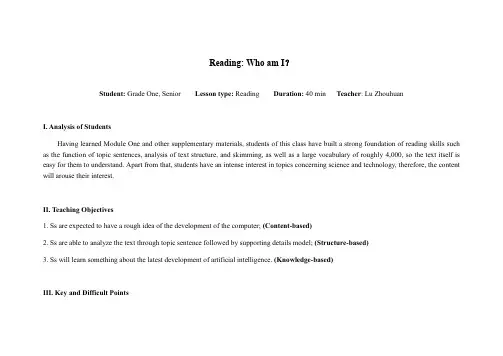
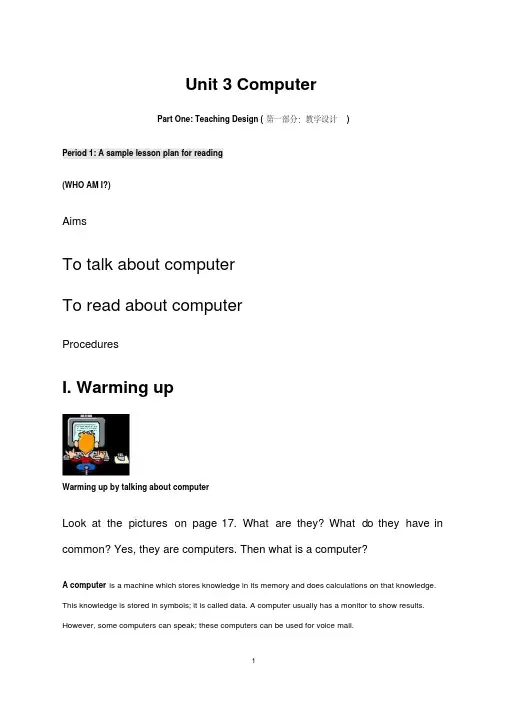
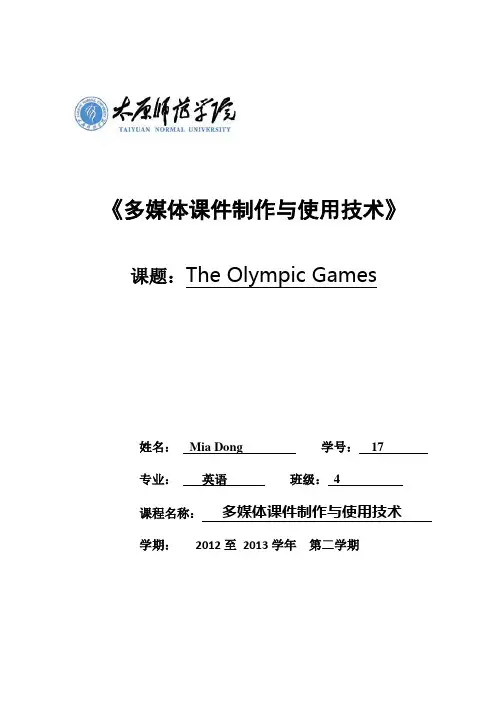
《多媒体课件制作与使用技术》课题:The Olympic Games姓名:Mia Dong 学号:17专业:英语班级: 4课程名称:多媒体课件制作与使用技术学期:2012至2013学年第二学期人教版高中英语必修二第三单元《The Olympic Games》教学设计Mia Dong 外语系4班17一、学情分析(一)学习者分析1、一般特征:学生基本上来自农村,英语水平参差不齐,学习压力大;学习策略与方法不合理,有的学生还不喜欢英语。
2、学习风格分析:对于高中生来说,学习的习惯和方法还是局限于较为死板,习惯于题海战术,很少有自发的对感兴趣的课题的研究或学习;学生习惯于上课认真听老师讲解,较少地参与主动地学习,一直是较为死板地学习,老师激发学生兴趣,使其主动融进课堂学习。
3、初学能力判断;既一个学期的高中英语学习后,学生的英语水平能力有提高,但还需继续努力;关于必修二已经学习了第一、二单元,学生基本可以接受第三单元的学习任务,前提是必须认真融入由教师带领的学习氛围中。
(二)教材分析本单元以世界性的体育盛会──Olympic Games 为话题,旨在通过本单元的教学,使学生了解奥运会的起源、宗旨、以及古现代奥运会的异同。
学会用英语表达自己的兴趣爱好以及如何向别人推荐某一种爱好,同时培养学生对体育运动的爱好。
二、教学目标教学要求:(一)教学模式关于第二单元本环节——reading部分,采用教学问答模式、课堂授受模式、指导自学模式、合作交流模式以及探究学习多种模式交叉运用。
(二)教学策略主要是使用替代式教学策略,使学生在短期内学习许多内容,提高教学效率。
其中穿插问题引导方式,从而克服单一的替代式教学策略的不足(三)教学方法以语言形式获得间接经验的方法为主,通过教师和学生口头语言活动及学生独立阅读书面语言为主,其中使讲授法、谈话法、讨论法和读书指导法交叉使用。
四、教学平台以多媒体课件演示为主,辅之以少量板书,即多媒体课件教室的教学环境。
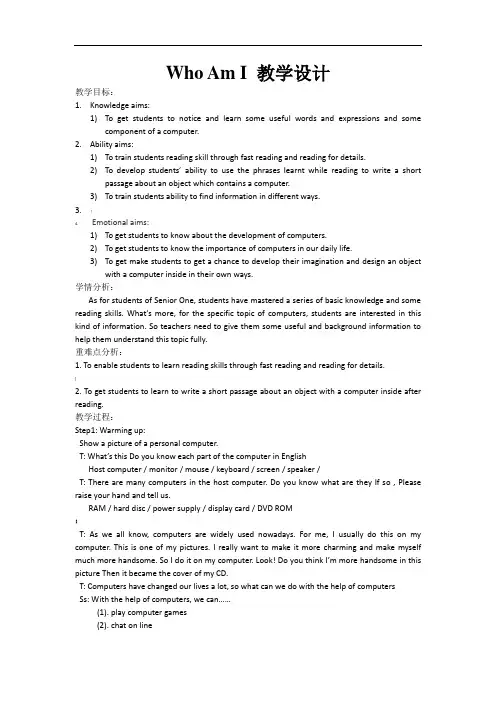
Who Am I 教学设计教学目标:1.Knowledge aims:1)To get students to notice and learn some useful words and expressions and somecomponent of a computer.2.Ability aims:1)To train students reading skill through fast reading and reading for details.2)To develop students’ ability to use the phrases learnt while reading to write a shortpassage about an object which contains a computer.3)To train students ability to find information in different ways.3.!4. Emotional aims:1)To get students to know about the development of computers.2)To get students to know the importance of computers in our daily life.3)To get make students to get a chance to develop their imagination and design an objectwith a computer inside in their own ways.学情分析:As for students of Senior One, students have mastered a series of basic knowledge and some reading skills. What’s more, for the specific topic of computers, students are interested in this kind of information. So teachers need to give them some useful and background information to help them understand this topic fully.重难点分析:1. To enable students to learn reading skills through fast reading and reading for details.}2. To get students to learn to write a short passage about an object with a computer inside after reading.教学过程:Step1: Warming up:Show a picture of a personal computer.T: What’s this Do you know each part of the computer in EnglishHost computer / monitor / mouse / keyboard / screen / speaker /T: There are many computers in the host computer. Do you know what are they If so , Please raise your hand and tell us.RAM / hard disc / power supply / display card / DVD ROM】T: As we all know, computers are widely used nowadays. For me, I usually do this on my computer. This is one of my pictures. I really want to make it more charming and make myself much more handsome. So I do it on my computer. Look! Do you think I’m more handsome in this picture Then it became the cover of my CD.T: Computers have changed our lives a lot, so what can we do with the help of computersSs: With the help of computers, we can……(1). play computer games(2). chat on line(3). send emails to friends(4). download music and films(5). search for information》(6). do business or work(7). use computer for school work(8). do on-line shopping……There is no doubt that computers are playing an important role (正起着重要的作用)in our daily life.Step2: ReadingFast-reading:T: Read through quickly and answer following two questions:1)、2)Who is the speaker3)Can you find the topic sentence of each paragraph•P aragraph 1.Over time, I have been changed a lot.•P aragraph 2.These changes only became possible as my memory improved.•P aragraph 3.Since the 1970s, many new applications have been found for me."Tip : Each topic sentence may have some key words which are closely related to the details in each paragraph.Reading for details:T: According to the key words, we can find more details in each paragraph. So first, read paragraph 1 and fill in the blanks.I began as a ____________ machine in 1642 in France. Nearly 200 years later, I was built as an___________ machine. Then in 1936, a book about how I could be made to work as a “__________ machine” was written. By the _________, I was as large as a room. As time went by, I was made ________. Since the 1970s, I have been used in offices and homes, first as a ______ and then as a laptop.T: according to paragraph 1, and these pictures, we can know what changedThe shape of the computer changed.The size of the computer first became_larger_ and then__smaller_.T: Read Paragraph 2 and answer following questions:(1) Why did these changes become possible2) How did the memory improve3) How did the computer share its knowledge with othersCheck the answers as a class.T: Read paragraph 3, and fill in the chart.Careful reading:T: Now, look at the timeline,. Let ’s read the passage again and find what happened at each time. 1936(1822)16421940s 1970sbegan as a calculating machine an analytical machine made by Charles Babbage a universal machine , Alan Turinga huge computer , as large as a room,30Careful reading: A timelineNow a personal computer and a laptop , and used in officesand homes since the 1970s …Connect peopleall over the worldtogether .1960s The first family of computers wasconnected to each other.(Check the answers by asking students to say it out one by one.T: After reading the passage, and according to the timeline, I ’m sure you can get the main idea of the passage.The passage is organized in the order of time .And the passage is mainly about the history of the development of the computer.Step 3 : After readingT: As time goes by, we live a better life of high quality with the help of the computer. But do youknow what computers are Are these all computers(show some pictures) Yes, they are in different shapes and sizes, but they are all computers or maybe devices with a computer inside. So , if you are a designer, can you design something useful with a computer inside Please have a pair work and make a wonderful design with you partner. Then I will ask some of you to have a report. I will give a prize for one of you whose design is the best. You are the judges, ok, let’s begin.Step 4: Ending:End the lesson by sharing three designs, and give the prize to the student whose design is the most popular.Step 5:Homework:Write a passage about your design and draw a picture beside it.。
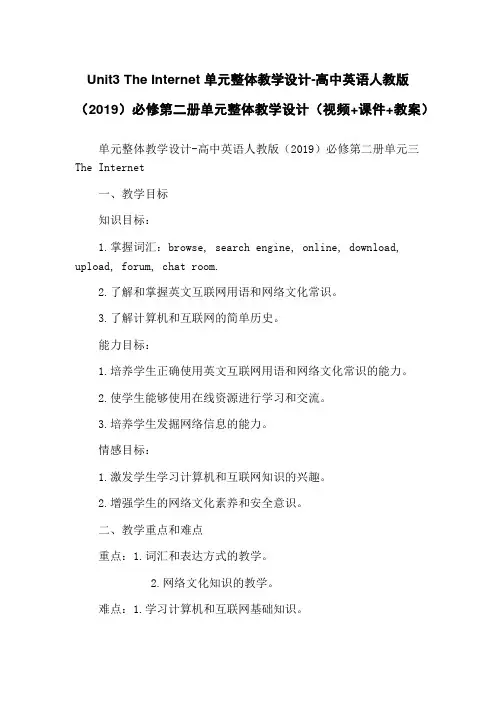
Unit3 The Internet 单元整体教学设计-高中英语人教版(2019)必修第二册单元整体教学设计(视频+课件+教案)单元整体教学设计-高中英语人教版(2019)必修第二册单元三The Internet一、教学目标知识目标:1.掌握词汇:browse, search engine, online, download, upload, forum, chat room.2.了解和掌握英文互联网用语和网络文化常识。
3.了解计算机和互联网的简单历史。
能力目标:1.培养学生正确使用英文互联网用语和网络文化常识的能力。
2.使学生能够使用在线资源进行学习和交流。
3.培养学生发掘网络信息的能力。
情感目标:1.激发学生学习计算机和互联网知识的兴趣。
2.增强学生的网络文化素养和安全意识。
二、教学重点和难点重点:1.词汇和表达方式的教学。
2.网络文化知识的教学。
难点:1.学习计算机和互联网基础知识。
2.正确使用英文互联网用语和网络文化常识。
三、教学方法和学法教学方法:1.讲授法。
2.小组讨论法。
3.图片展示法。
4.互联网资源利用法。
5.语言应用法。
学法:1.自主学习法。
2.合作学习法。
3.实践探究法。
4.信息获取法。
四、教学内容与时间分配课时安排:第一课时:词汇表达技巧学习第二课时:网络文化知识学习第三课时:计算机和互联网基础知识学习第四课时:合作学习——信息获取具体内容:1.第一课时:词汇表达技巧学习(40分钟)1.1 Target language设计1.2 听录音,完成练习1.3 词汇活动:运用十分钟单词表格口头表达“十分钟内学了哪些单词”来加深单词理解和记忆2.第二课时:网络文化知识学习(40分钟)2.1 通过图片PPT展示网络文化现象。
2.2 讨论互联网上的信息内容和发布及获取信息的方法。
2.3 合作讨论如何保护个人信息的重要性。
2.4 以小组作品展示的形式分享观点。
3.第三课时:计算机和互联网基础知识学习(40分钟)3.1 观看视频,了解计算机和互联网的起源和发展。
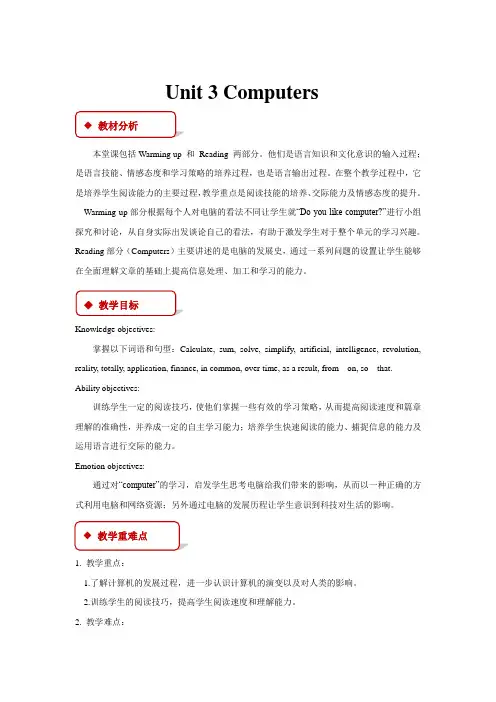
Unit 3 Computers本堂课包括Warming up 和 Reading 两部分。
他们是语言知识和文化意识的输入过程;是语言技能、情感态度和学习策略的培养过程,也是语言输出过程。
在整个教学过程中,它是培养学生阅读能力的主要过程,教学重点是阅读技能的培养、交际能力及情感态度的提升。
Warming up 部分根据每个人对电脑的看法不同让学生就“Do you like computer?”进行小组探究和讨论,从自身实际出发谈论自己的看法,有助于激发学生对于整个单元的学习兴趣。
Reading 部分(Computers )主要讲述的是电脑的发展史,通过一系列问题的设置让学生能够在全面理解文章的基础上提高信息处理、加工和学习的能力。
Knowledge objectives:掌握以下词语和句型:Calculate, sum, solve, simplify, artificial, intelligence, revolution, reality, totally, application, finance, in common, over time, as a result, from···on, so···that. Ability objectives:训练学生一定的阅读技巧,使他们掌握一些有效的学习策略,从而提高阅读速度和篇章理解的准确性,并养成一定的自主学习能力;培养学生快速阅读的能力、捕捉信息的能力及运用语言进行交际的能力。
Emotion objectives:通过对“computer”的学习,启发学生思考电脑给我们带来的影响,从而以一种正确的方式利用电脑和网络资源;另外通过电脑的发展历程让学生意识到科技对生活的影响。
1. 教学重点:1.了解计算机的发展过程,进一步认识计算机的演变以及对人类的影响。
2.训练学生的阅读技巧,提高学生阅读速度和理解能力。
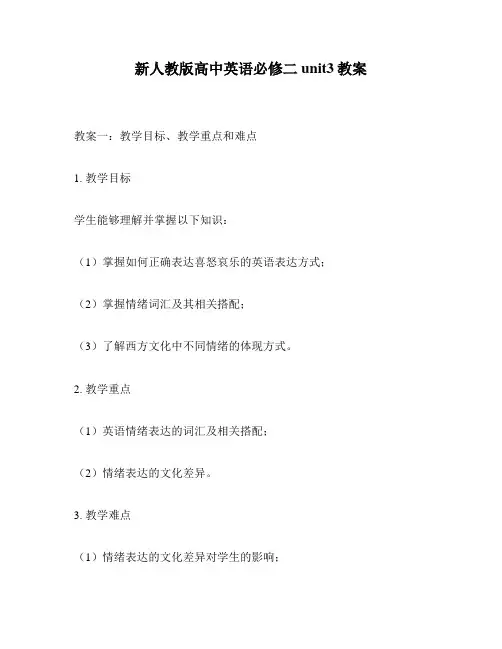
新人教版高中英语必修二unit3教案教案一:教学目标、教学重点和难点1. 教学目标学生能够理解并掌握以下知识:(1)掌握如何正确表达喜怒哀乐的英语表达方式;(2)掌握情绪词汇及其相关搭配;(3)了解西方文化中不同情绪的体现方式。
2. 教学重点(1)英语情绪表达的词汇及相关搭配;(2)情绪表达的文化差异。
3. 教学难点(1)情绪表达的文化差异对学生的影响;(2)如何正确地表达复杂的情绪。
教案二:教学内容和方法1. 教学内容(1)英语情绪表达的词汇及常用搭配(2)文化差异与情绪表达(3)小组活动:你的表情有何含义?2. 教学方法(1)词汇教学法(2)讨论法(3)小组活动教案三:教学过程Step 1:引入以一个小故事开始引入,讲述在不同文化下表达情绪的不同方式,引发学生对文化差异在情绪表达方面的影响的思考。
Step 2:情绪词汇与表达方式通过PPT或教材上的词汇表,给学生介绍英语中表示情绪的词汇及其相关搭配,例如:be over the moon(非常高兴),lose one's temper (发脾气),burst into tears(突然流泪)等等。
同时,介绍表达情绪的非语言方式,例如肢体语言、面部表情、声音等。
Step 3:文化差异与情绪表达通过讨论,让学生深入了解不同文化对情绪表达的影响。
例如在一些东方国家,表现出太多的情感是不被认同的,而在西方国家,人们更加倾向于直接表达自己的情绪。
Step 4:小组活动让学生分组,用不同的表情来表示各种情感,并学习如何用语言和表情配合来准确地表达复杂的情绪。
每个小组可以准备短小的话题,如“生气了怎么说”,“开心了怎么表现”等等,然后在小组内进行讨论和表演。
Step 5:总结及作业布置通过展示各小组的表演,总结学生所学的情感表达方式及相关文化差异。
同时布置作业,要求学生在家中观察家人或朋友的表情和肢体语言,记录下来并分析。
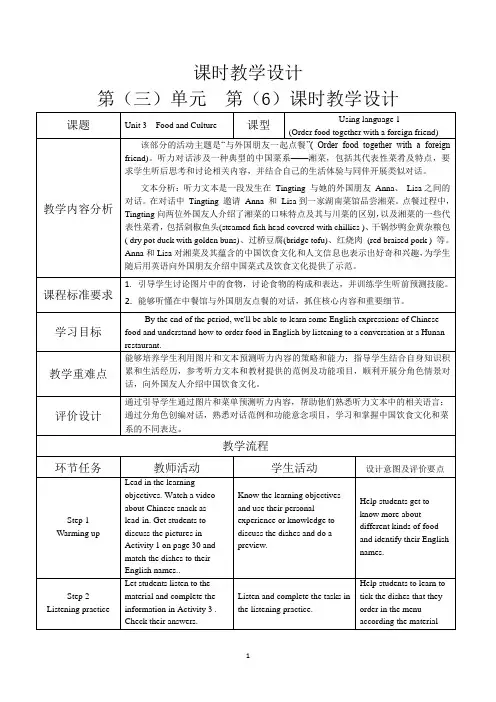
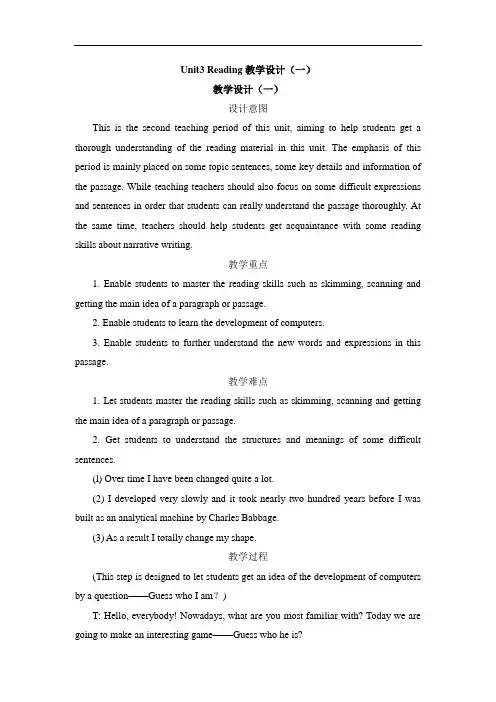
Unit3 Reading教学设计(一)教学设计(一)设计意图This is the second teaching period of this unit, aiming to help students get a thorough understanding of the reading material in this unit. The emphasis of this period is mainly placed on some topic sentences, some key details and information of the passage. While teaching teachers should also focus on some difficult expressions and sentences in order that students can really understand the passage thoroughly. At the same time, teachers should help students get acquaintance with some reading skills about narrative writing.教学重点1. Enable students to master the reading skills such as skimming, scanning and getting the main idea of a paragraph or passage.2. Enable students to learn the development of computers.3. Enable students to further understand the new words and expressions in this passage.教学难点1. Let students master the reading skills such as skimming, scanning and getting the main idea of a paragraph or passage.2. Get students to understand the structures and meanings of some difficult sentences.(l) Over time I have been changed quite a lot.(2) I developed very slowly and it took nearly two hundred years before I was built as an analytical machine by Charles Babbage.(3) As a result I totally change my shape.教学过程(This step is designed to let students get an idea of the development of computers by a question——Guess who I am?)T: Hello, everybody! Nowadays, what are you most familiar with? Today we are going to make an interesting game——Guess who he is?Guess who I am?It’s a long history...From then on, I grew rapidly both in size and in brainpower.As time went by, I was made smaller. First as a PC.Then as a laptop.As a result my memory became so large that even I couldn’t believe it!I am a computer!思考引导As we can see from the pictures, computers have developed fast lately, so are you interested in exploring more detailed information?课堂探究Step 1 Reading(This step focuses on helping students develop skills of getting the main idea of a passage. At the same time, let them get some information for the development of computers.)1. SkimmingRead the text quickly and try to find out the topic sentence for each paragraph.Matching work:Suggested answers: 1. Paragraph 2 2. Paragraph 3 3. Paragraph 12. ScanningDraw the timeline (时光轴) and find the relevant (相关的) events.1642 The computer began as a calculating machine.。
人教版高中英语必修2《Unit 3 Computers》教案人教版高中英语必修2《Unit 3 puters》教案【一】教学准备教学目标1. To practise listening prehension.practise making decisions and reasoning教学重难点1. To practise listening prehension.practise making decisions and reasoning教学工具课件教学过程Step1. revision1. check the homework exercises.1). It has been reported that children will be offered free education. It has been reported that free education will be offered to children.2). It has been said that we will be offered the latest puter science course book.It has been planned that the latest puter science course book will be offered to us.3). I have been told by Peter that I will be lent his notebook puter for a week.I have been told by Peter that his notebook puter will be lent to me for a week.2. Question: What can puters be used as?Step2. Lead-inAs we know, science and technology is developing very fast and puters have bee smaller and smaller. They have been used in many fields. So, the 21st century is the century of information technology What does it mean?Does information technology/ IT only mean things like puters? Of cause not. Actually, it means more than puters. puters are just one kind of IT. What else do you know is part of IT?(TV, radio, CD-ROM, DVD, books)Step3. Listening (SB)1. Pre-listening: What are the changes brought by different forms of IT ?What are the advantages and disadvantages of them ?2. While-listening:Go through the chart and make sure the students look at the chart before they listen to the tape. (This is to sharpen their attention and listen for the answers. This will also help them get the gist of the text.) Then Listen to the tape and finish filling in the chart. (If necessary, play the tape for several times.)Say: After listening to their talk, we know all kinds of IT have both disadvantages and check the answers together.Type of IT Advantages DisadvantagesTV You can both listen and watch. You cannot write to friends.Web You can find information. It is very expensive.Radio You can listen to English. You cannot watch a film.Book You can get information. Sometimes it is out of date.3. Post-listening:1) (pair work): decide which type of IT is best for you to use right now. Make your choice and give your reasons by using the following expressions.I think that.In my opinion, .I believe that.I agree because.I disagree because.Ive decided that.2) (group work): Discussion :puters are useful and have brought us lots of good things, but they also cause bad effects. What attitude should we have towards the puter? (Make good use of it but never get trapped by it.)Step4. Speaking1. Pre-speakingSay: From what we have learn, we should admit that puters and the web have a great influence on the school education as well as peoples life. It has e into peoples everyday life and many families hold puters in their homes. Now there is a task for you.2. While-speaking1) Situation: You have been asked by your parents to help choose puters for your home. You and your friend have looked at several puters. Talk about the special things each puter can do. Make a decision about which kind of puter to buy and explain why.Information input: Show students some pictures of different puters (desktop puter laptop puter )Language input: Useful expressions (Repeat it to strengthen students ability of use it.)Supporting an opinion Challenging an opinionI think that , because Perhaps, but what if / about ?First, Have you thought about ?One reason is that What makes you think that ?I think it is better because I dont like it because.(Pair work )Use the expressions to support your opinion or challenging others opinions.2) Oral report: (inpidual work )Do an oral report to your father and start your report like this: I looked at many different puters. The one I have chosen is the PEP personal puter. One of the main reasons is that it is suitable for homes. I found that3. Post-speakingConclusionWhat useful expression do we use to make a decision and reason?(In this way, they can review and use the words and phrases again.) Step6 Pre-writingSay: Imagine what problems and delights this android might have to deal with while it is serving you. Try yourself in someone elses shoes is an important way of understanding how other people feel.Then discuss: You are an android. You work for a family with one child who is very spoiled. The parents want you to do everything for them. The parents are nice, but they often ask you to watch over their child. How do you feel? What would you do if the child asked you to do his homework for him? Would you ever tell the child no?Step7 WritingSay: Write a passage about the result of your discussion! It should contain:What do you have to do?What is the child like?What is the parents requirement of the child?What do the parents want you to do?What does the child want you to do?Then what will you do? How do you feel?Sample writing:Hello everybody, my name is Liu am a 321 model work for the Li family. Mr and Mrs Li work very hard Li is an architect and designs great tallapartment Li is a doctor and has to look after many remember all the plans for Mr Li’s projects and can tell Mrs Li which drugs are the best to give any particular patient. And I also look after their library. I store all the books that they borrow from their school or friends in my course my brain is as large as a mountain, so work like that is no trouble to really eat books just like people eat food.The Lis have a child who is very spoiled. He needs me to remember all his school textbooks so that I can do his homework for just gives me the information on the subject, what has to be done and the page numbers and I get on with it while he enjoys himself with his I don’t think it is right to do his homework for him it’s somewhat cheating. However, his parents are very concerned at the pressure of work in school these child has too much homework to do. They like him to go to the key school but they also want him to be able to have hobbies, learn to swim and keep fit! Poor child!So they consider me the most important person in the family after am always introduced to their friends and play with visiting am the perfect family academic aid and, although I was not cheap to buy, Mr Li says I was worth every yuan!Step8 AssessmentGet the students to assess their writing ability according to the following the questions:1. Is your position well developed?2. Are your ideas well organized to the point?3. Do you have a good choice of words and idioms in your writing?4. Do you get a good mastery of plex structures of language?5. What kind of mistakes have you made in your writing?Step9: HomeworkWrite about your discussion. You may begin like this:Hello, everyone. My name is ___. Im 321 model android. I work for the Li family.课后小结学了这节课,你有什么收获?课后习题完成课后习题一、二。
《多媒体课件制作与使用技术》课题:The Olympic Games姓名:Mia Dong 学号:17专业:英语班级: 4课程名称:多媒体课件制作与使用技术学期:2012至2013学年第二学期人教版高中英语必修二第三单元《The Olympic Games》教学设计Mia Dong 外语系4班17一、学情分析(一)学习者分析1、一般特征:学生基本上来自农村,英语水平参差不齐,学习压力大;学习策略与方法不合理,有的学生还不喜欢英语。
2、学习风格分析:对于高中生来说,学习的习惯和方法还是局限于较为死板,习惯于题海战术,很少有自发的对感兴趣的课题的研究或学习;学生习惯于上课认真听老师讲解,较少地参与主动地学习,一直是较为死板地学习,老师激发学生兴趣,使其主动融进课堂学习。
3、初学能力判断;既一个学期的高中英语学习后,学生的英语水平能力有提高,但还需继续努力;关于必修二已经学习了第一、二单元,学生基本可以接受第三单元的学习任务,前提是必须认真融入由教师带领的学习氛围中。
(二)教材分析本单元以世界性的体育盛会──Olympic Games 为话题,旨在通过本单元的教学,使学生了解奥运会的起源、宗旨、以及古现代奥运会的异同。
学会用英语表达自己的兴趣爱好以及如何向别人推荐某一种爱好,同时培养学生对体育运动的爱好。
二、教学目标教学要求:(一)教学模式关于第二单元本环节——reading部分,采用教学问答模式、课堂授受模式、指导自学模式、合作交流模式以及探究学习多种模式交叉运用。
(二)教学策略主要是使用替代式教学策略,使学生在短期内学习许多内容,提高教学效率。
其中穿插问题引导方式,从而克服单一的替代式教学策略的不足(三)教学方法以语言形式获得间接经验的方法为主,通过教师和学生口头语言活动及学生独立阅读书面语言为主,其中使讲授法、谈话法、讨论法和读书指导法交叉使用。
四、教学平台以多媒体课件演示为主,辅之以少量板书,即多媒体课件教室的教学环境。
五、教学计划本单元用6课时第一课时: Warming up and listening第二课时: Speaking第三课时: Reading第四课时: Reading第五课时: Language study第六课时: Integrating skills(注:本课件为教学计划中的第三课时)六、教学动力和动机关于第三单元本环节教学,教师通过展示学生普遍关注的或喜欢的图片调动学习兴趣,并且共同讨论学习各种有趣的运动调动学生学习积极性,并告知学生在reading后有课堂测验,从而使学生感到较小的压力,促进学习积极性,进而完成教学任务和教学目标。
七、教学具体环节(一)课件第一部分以上图片作为本课时教学的第一屏1、以Microsoft PowerPoint 2012版本“生如夏花”为主题的模板,并且包括后面的十几屏都继续使用本模板,使之成为一个整体,体现“青春”、“活力”、“激情”、“运动”等含义,不仅与本单元主题——“奥运会”精神相契合,并且为学生所喜爱,使之激发兴趣,从而更好地投入学习中;2、使学生树立这样的思想,即青春奥运,激情的梦想在奥运(运动)、在学习,时刻充满激情,乐观积极向上地面对每一天,进而达到教学目标的情感价值观这一目标,把教学思想和目标贯彻整个教学过程。
(二)课件第二部分主要有2008北京奥运会、奥运五环和奥运精神为内容,包括多媒体课件第二、三、四屏以上图片作为本课时教学的第二屏。
1、给学生展示一幅2008年北京奥运会的主题馆鸟巢的矢量图,让学生自由发挥讨论关于北京奥运会的任何话题任何事件。
此环节应控制在5分钟左右,充分运用合作探究学习;2、讨论结束后,教师应该加以评价,并且补充学生讨论话题的内容,丰富学生对北京奥运会的了解,激起学生学习兴趣;3、作为情景创设,导入新课,为下面的教学活动做铺垫。
以上图片作为本课时教学第三屏1、暨北京奥运会的一番讨论之后,教师再深入话题,同样让学生自由讨论关于奥运五环的意义,次环节应控制在2到3分钟内;2、教师提问学生,使其叙述讨论成果,并分享给全班同学;3、因为关于本环节的问题较为普遍,一般学生了解比较多,所以实施起来较为容易。
教师对于学生的回答应该加以表扬为主,增加学生自信心;4、同样的,本环节依旧采用了合作探究学习,即问题—探究—答辩—评价,接着进行下一个环节教学活动以上图片为本课时教学第四屏1、此环节,旨在让学生理解并记忆奥运精神的内容,此项内容为教学重点,需要学生掌握;2、通过教师展示三幅相关的形象的图片加以记忆,更直观,更具有视觉冲击,便于记忆;3、此外,教师可让学生齐声大声朗读奥运精神的内容,通过反复朗读,巩固记忆;4、该环节主要通过行为感知理论,通过图片直观地刺激视觉神经,使其感知内容,又通过朗读,信息反馈到大脑,从而形成固定的概念;5、本环节的时间可控在五分钟左右。
(三)课件第三部分第三部分主要以介绍reading部分背景知识为主,包括多媒体课件第五、六、七屏以上图片为本课时教学第五屏1、作为后面的reading部分的背景知识介绍,本课件内容要求学生作为了解内容;2、同样地,通过直观认识,借助图片,是学生了解关于古代奥运会的相关知识,为后面的reading学习做铺垫;3、教师对于图片进行讲解,学生进而接受;4、本小环节时间大概可以控制在3分钟以内。
以上图片为本课件第六屏1、继续前面的,本环节依然接着介绍现代奥运,关于现代奥运的起点,通过一幅海报和第一届现代奥运的比赛场地图片增加学生对于现代奥运和古代奥运的理解,辅之以教师讲解图片内容;2、该内容主要为拓展内容,学生学习目标为了解,3、次环节教学活动应控制在两分钟以内。
以上图片为本课件第七屏1、与第五屏相反,第七屏介绍现代奥运的相关知识;2、同样地,作为了解内容,该小环节的教学目标和教学时间与上面第五、六屏相同。
(四)、课件第四部分该课件第四部分主要将reading所涉及到的单词罗列出来,包括课件第八屏和第九屏1、此时,经过前面各种背景知识作为前奏,教学活动进入重点,2、对于单词部分,教师要引着学生对于单词进行学习,包括发音、意思;3、教学目标是,初步认识单词,便于后面reading的学习;、4、时间限制在十到十五分钟。
(五)、课件第五部分本环节主要包括第十、十一、十二屏,是对于reading的学习1、本环节是这一课时的教学重点也使教学难点,前面各种介绍都是为本环节服务。
要求让学生进一步熟悉掌握一些阅读技巧,如快速找寻文章细节信息、归纳和总结等;2、这属于学生自学阶段,培养学生的阅读理解能力。
鉴于阅读理解在高中学生平时的英语考试还有高考中所占的比例较大,所以对于平时的训练是非常必须的,此时,教师和学生都必须严谨对待。
更大方面的讲,本身阅读理解对于英语学习是重头戏,是英语教学的重点也是难点;3、主要是通过教师出题,然后学生通过快速阅读了解文章内容,寻找有效信息,从而达到对阅读理解的锻炼。
毫无疑问,这样的学习方式是很多英语老师所喜欢用的,得到较为广泛的运用。
此外,这里主要对于第十二屏进行详细解说,如下图为课件第十二屏以上为课件第十二屏1、通过表格的方式,把reading部分的内容罗列出来,清晰、直观、可读性强,2、其中,表格挖掉一部分内容,要求学生通过第二次快速阅读,抓住更大的更有效地信息,并且对信息进行处理,深入了解内容;3、本环节,教师还可以给学生提供一些较为有效地阅读方法,并且使学生加以运用,形成属于自己的阅读学习习惯,并且长久地沿袭下去,不断对于学习方法的完善,从而提高学习效率;4、本环节,教师可根据问题难易程度设置教学活动的时间安排,本课件安排时间为:第一次阅读5分钟;第二次阅读五到十分钟。
5、此外,教师留一部分时间,可以是五分钟以内,供学生小组讨论,互相交流有效信息,互相改进、提高,发挥合作探究学习的好处。
(六)、课件第六部分本环节主要包括第十三屏,在学生已经对reading部分内容了解的情况下,要求学生写一篇关于奥运会发展的作文,是学生对已学内容加以整理和巩固知识,并且添加进自己的看法,对于学生思维拓展或者深入思考都有很好的锻炼,教师提供一个平台,给学生锻炼发展。
就情感态度价值观方面,本环节可以培养学生对于奥运的热爱,培养积极向上的生活和学习态度,就像奥运会一样充满青春的激情和活力,追求更快、更高、更强。
八、教学评估(一)形成性评价1、通过教学第五部分,形成性评价贯穿其中,检测学生对于本节课的学习成果,但据初步预计,在本环节中,学生整体学习情况较好,原因是合作探究学习的好处;2、对于本课时教学,教师可以在下节课的时候对于学生本节课的课后作业加以点评,对于好的作品表扬,总体上鼓励学生培养善于思考的习惯,不断反思对于已学内容,并且内化为学生自己的知识,充分体现教育的本质——获得生存的本领和能力,不断完善个人。
(二)总结性评价1、对于该课时的时间安排,教师应更多的空出时间让学生自学和小组讨论学习,最重要的是对阅读理解能力的锻炼,教师对其学习方法进行评价,并且给予较为有效地阅读方法和策略,且成为习惯,使学生学习效率提高;2、关于课件制作,教师可以多加以修改,尽可能的从学生的角度去审视课件内容的可实施性、可读性等;3、总体来说,本课时教学较为简单,学生易于接受。
教学进程中的对于学生设置的问题,难易程度较低,所以整体是比较能接受的;4、在完成本课时教学后,教师准备安排下一课时的教学内容,即对于reading部分词汇和语法方面的深入讲解以及对课文内容的深入等。